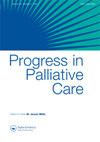晚期癌症患者使用提前护理计划的患病率和类型:回顾性单中心视角,澳大利亚
IF 0.8
Q4 PUBLIC, ENVIRONMENTAL & OCCUPATIONAL HEALTH
引用次数: 0
摘要
目的:在澳大利亚,预先护理指示的参与率为14%,对晚期癌症患者的预先护理计划(ACP)邀请和接受的研究有限。本研究确定了在接受化疗后两到四周内死亡的PwAC中记录的ACP讨论的患病率和类型。设计:进行了回顾性审计。采用SPSS软件进行统计分析。通过Kruskal-Wallis和卡方(或Fisher Exact)检验测量三组[对照组、<2周和-4周]之间ACP邀请和利用的差异。进行事后随访配对比较。使用两个逻辑回归模型估计调整后的患病率。背景:本研究在澳大利亚XXX海岸大学医院进行。参与者:检查了339名患者的记录,发现320名患者符合条件。结果:在320名PwAC患者中[男性:55%;中位年龄:65岁],227人(71%)接受了ACP邀请,在受邀患者中,89%使用了急性复苏计划;54%的人使用了持久授权书;20%完成了《高级健康指令》。从7.5% = 24]在生命的最后两周接受化疗的患者中,42%没有接受ACP邀请,29%没有急性复苏计划,只有4%完成了预先健康指示。对照组、<2周组和2-4周组在完成急性复苏计划方面存在显著差异(P = 0.003)和高级健康指令(P = 0.045)。自使用急性复苏计划以来,对照组和<2周组之间的天数也存在显著差异。完成急性复苏计划与化疗后两周内死亡风险较低相关(OR = 0.246;P = 结论:PwAC的ACP邀请率和使用率较低,尤其是在死亡2周内接受化疗的患者,证实了在癌症护理中嵌入并定期重新访问ACP框架的必要性,并教育工作人员、患者及其家庭护理人员以提高接受率。本文章由计算机程序翻译,如有差异,请以英文原文为准。
The prevalence and types of advance care planning use in patients with advanced cancer: A retrospective single-centre perspective, Australia
Objectives: In Australia participation rate in Advance Care Directives is 14%, and research is limited on Advance Care Planning (ACP) invitations and uptake among the patients with advanced cancer (PwAC). This study identifies the prevalence and types of documented ACP discussions in PwAC who died within two or four weeks of receiving chemotherapy. Design: A retrospective audit was conducted. Statistical analysis was calculated in SPSS. Difference in ACP invitation and utilization between three groups [control, <2-weeks, and –4 weeks] was measured by Kruskal–Wallis and Chi-square (or Fisher-Exact) tests. Post-hoc follow-up pair-wise comparisons were performed. Adjusted prevalence ratios were estimated using two logistic regression models. Setting: This study was conducted in XXX Coast University Hospital, Australia. Participants: The records of 339 patients were examined and 320 patients were found eligible. Results: Of the 320 PwAC [male: 55%; median age: 65 years], 227 (71%) received ACP invitation, and among the invited patients, 89% used Acute Resuscitation Plan; 54% used Enduring Power-of-Attorney; and 20% completed Advance Health Directives. From 7.5% [n = 24] of the patients who received chemotherapy in their last 2-weeks of life, 42% had not received an ACP invitation, 29% didn’t have Acute Resuscitation Plan and only 4% completed Advance Health Directives. There were significant differences among Control, <2-weeks, and 2–4 weeks groups in completing Acute Resuscitation Plan (P = 0.003) and Advance Health Directives (P = 0.045). A significant difference was also observed between control and <2-weeks groups in number of days since Acute Resuscitation Plan used. Completing an Acute Resuscitation Plan was associated with a lower risk of dying within two-weeks of chemotherapy (OR = 0.246; P = 0.008). Conclusions: Low rates of ACP invitation and use in PwAC, especially who received chemotherapy in 2-weeks of dying confirm a need for embedding and regularly revisiting ACP framework in cancer care and educating staff, patients, and their family caregivers to increase uptake.
求助全文
通过发布文献求助,成功后即可免费获取论文全文。
去求助
来源期刊

PROGRESS IN PALLIATIVE CARE
PUBLIC, ENVIRONMENTAL & OCCUPATIONAL HEALTH-
CiteScore
2.60
自引率
11.80%
发文量
24
期刊介绍:
Progress in Palliative Care is a peer reviewed, multidisciplinary journal with an international perspective. It provides a central point of reference for all members of the palliative care community: medical consultants, nurses, hospital support teams, home care teams, hospice directors and administrators, pain centre staff, social workers, chaplains, counsellors, information staff, paramedical staff and self-help groups. The emphasis of the journal is on the rapid exchange of information amongst those working in palliative care. Progress in Palliative Care embraces all aspects of the management of the problems of end-stage disease.
 求助内容:
求助内容: 应助结果提醒方式:
应助结果提醒方式:


